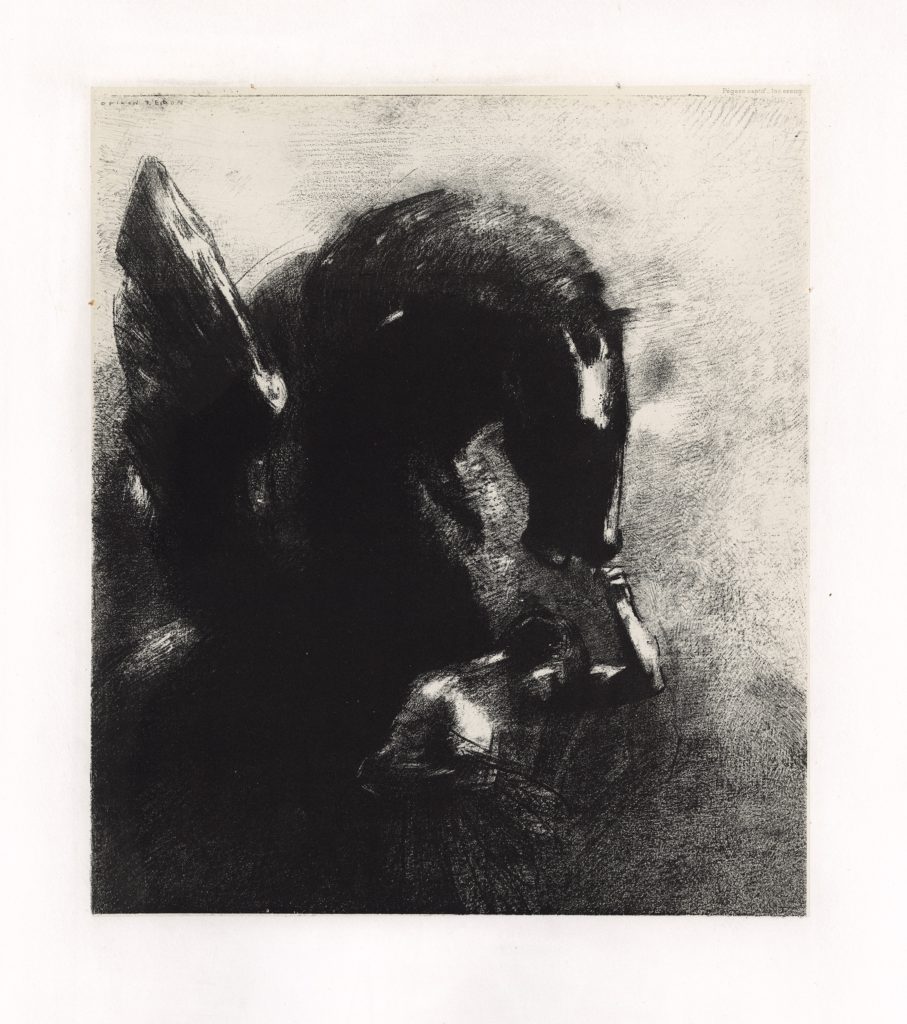This is a very fine impression of the 1st state, called the “black state” to distinguish it from the second. Redon lightened and reworked this extensively, scraping-back and employing liquid tusche on the horse’s wing, probably in 1891, around three years later. Along with the Spider and the Tree, the present composition Pégase Captif is one of the most powerful and important lithographs by Redon, if not one of the rarest.
This first state is more dramatic in terms of effect and tension of the subject. Only about seven or eight proofs of this first state are currently recorded – at the Art Institute of Chicago, the British Museum (presented by Achille Sirouy in 1888), three in private collections and the current impression. Of those in private collections, one appeared on the English market in the 1960s (location unknown), another was formerly owned by Otto Schäfer (now private collection, USA), and the last came from a private collection in France (now private collection, USA). The BM provenance is meaningful: Sirouy was a member of the Société des Artistes Français, which promoted the rich blacks, obtainable in lithography instead of the colour lithograph.
Both first and second state copies bear the same information about an edition of 100 impressions. However, both Destrée (1891), who had the information from Redon himself, and Mellerio (1913) stated that only around twenty-five impressions were in fact printed of the 1st state, and fifty for the 2nd. In a letter dated 7 November 1891 to his friend and editor Edmon Deman – who had asked for impressions – Redon mentioned that he had only printed eight sheets. We may assume that he was thinking of this first state, printed in 1888 (the 2nd state was printed in ca. 1893). To give another example, the Bibliothèque Nationale of France only has two copies from the 2nd state (although one of them was sometimes wrongly considered as a 1st state, they have the typical features of the 2nd state: lighter wings and lithograph retouches).
The present one is resplendent, with all the power of Redon’s deep blacks, and large margins. The wings are full of black. Redon is known to have signed only the fine impressions from the press. When signed by pencil in capitals, most of the time is in the upper left. The tiny white dots visible on the horse’s belly are typical of the 1st state, a detail that can also be seen, for instance, on the 1st state impressions of the Art Institute of Chicago and the British Museum.
The subject reflects Redon’s study of the myth of Parnassus, most particularly of the figure of Mercury in harmony with the winged horse Pegasus. He may have been inspired by Mantegna’s Parnassus painting at the Louvre, where the two figures appear at the right side. In the lithograph, Mercury holds Pegasus captive by the muzzle, while the powerful but tamed Pegasus seems to protect Mercury. Redon was attracted to this motif and utilized it in a number of his own Pegasus compositions from the early 1890s to 1900. Others have linked this composition to the myth of Bellerophon, who captured Pegasus.






